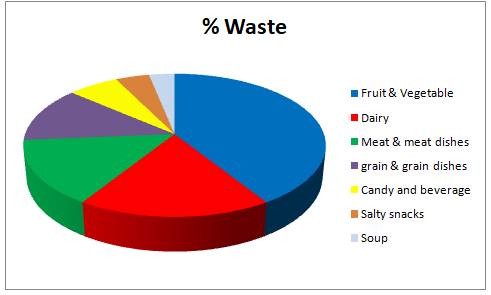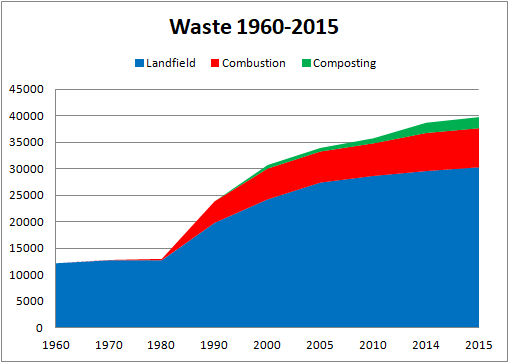The Food Waste Problem and How to Reduce It
The magnitude of the problem
In an article about the relationship between food waste, diet quality, and environmental sustainability the USDA scientists showed that Americans waste is around one pound (422 g) of food per person each day. This means that Americans waste 150,000 tons of food daily. People who eat a healthier diet that is rich in fruit and vegetables are the most wasteful. Fruit and vegetables require less land to grow than other foods (such as meat) but require a larger amount of water and pesticides.
As shown in the figure below, fruits and vegetables (including mixed fruit and vegetable dishes) were most likely to be thrown out and accounted for 39% of the food waste. The next most common category was dairy (17%), then meat and mixed meat dishes (14%), and grains including grain mixed dishes (12%). The remaining foods and dishes accounted for 6-3% each.
Percentage of food waste by category
.
A report by the Center for Biological Diversity found that just four of the ten largest grocery chains in the US had specific food waste reduction commitments. Walmart achieved the highest grade, of a B, Trader Joe’s, Target and Whole Foods all did poorly, with a D, while Aldi US was the worst.
The EPA compiled data on the amount of municipal solid waste (MSW) between 1960 and 2015. It shows the significant increase in food waste and the massive amount of waste being created (40 million tons in 2015). It also shows that as food waste increases, most of it goes into the land field with little effort to manage it in an environmentally friendlier way.
Food waste between 1960-2015
The USDA report shows that 30-40% of all food produced in the United States ends up in a landfill.
The USDA estimated that in 2010, American food waste did cost about $160 billion. The excessive food waste has an environmental toll of 20% of total U.S. climate damaging methane emissions that originate from landfills. The EPA reports that methane is 25X more harmful than CO2 over a 100-year period, and landfills account for 16% of all methane emissions in the U.S.
Food waste campaign by the US government
On September 16, 2015, the USDA and EPA announced the food loss and waste goal in the U.S., setting the domestic goal to 50% reduction on food loss and waste by 2030. The U.S. government invited private companies to join in this effort.

Some of the means to reduce waste is by improving product development to get more stable foods, enhancing control over storage conditions, applying more effective ordering systems, changing labeling and cooking methods. Another initiative is to connect potential food donors and hunger relief organizations such as food banks. Better recycle food waste such as composting for fertilization, and animal feed can also help in preventing food waste.
Organizations that currently create food waste are invited to join the U.S. Food Waste Challenge.
The FDA and the food labeling change: Is it a solution
The FDA is requesting that the food industry adopts the phrase “best if used by” for packaged food date labels in order to reduce consumer confusion and food waste. In a letter to the food industry, the FDA said that confusion over date labeling accounts for about 20% of consumers’ food waste. While based on the data above, this estimate seems to be high, but it is a step in the right direction, mainly to clarify the confusion created by the different terms used (such as “use before,” “sell by,” “expires on” and many others). This effort by the FDA is part of the White House initiative called “Winning on Reducing Food Waste”.
It is also part of the US government campaign described above to educating consumers on ways to reduce food loss and waste, and how to do it safely without risking illness from consuming spoiled food. The use of the expression “best if used by” also reminds the consumers that most foods can still be safe to eat if they’re past the marked date, even if they’re not necessarily as tasty anymore. It is important to mention that there is no federal mandate to the use of a date label on most foods (the only exception is infant formula). The expiration dates on the labels are just supposed to convey the quality and freshness of the food, not whether it is safe to eat.
Means to reduce food waste

When consumers throw food, they are throwing out money. The waste is not limited to consumers, supermarkets, and food producers. It also generates large amounts of waste.
According to Forbes while the world produces 17% more food than it did 30 years ago, almost half of it never gets eaten. Although more food is being produced, nearly a billion people still don’t have enough to eat.
The FDA has a page dedicated to tips on how to reduce food waste. The FDA has many common sense tips that include preplanning the shopping list to prevent overbuying and avoiding buying in bulk short shelf-life items that cannot be consumed on time. They suggest buying “Ugly” produce that has physical imperfections.
The USDA and the EPA have their lists of suggestions as one can find in several websites (e.g., https://tommyssuperfoods.com/food-waste-in-america-2019-stats-and-charts/). Some of their suggestions include:
• Composting as great way to help reduce waste and help the environment
• Looking at the food packaging and if possible using recyclable packaging
• Avoiding plastic packaging when possible, and cutting down on the plastic packaging in landfills and other parts of the environment.
• Reducing food waste by buying frozen foods that have a longer shelf life, resulting in the ability to keep them almost indefinitely without going bad.
At the American Association for Advancement of Sciences Annual Meeting in Washington, D.C. on February 14, 2019, Michigan State University reported that a survey of the attitude to food waste of 2,090 Americas revealed that 88 % of the surveyed people said they take steps to reduce food waste at home.
While the effort might be there, the results of quantities of food waste do not support that enough is being done.



One response to “The Food Waste Problem and How to Reduce It”
Denmark Solution to food waste
Denmark reduced its food waste by 25% in 5 years. The reduction effort involved Supermarkets to participate in food waste reduction, and opening a unique Supermarket to sell exclusively surplus food. The non-profit, volunteer-run store sells only recently expired food products or food with minor flaws or damaged packaging. Creating an application, which connects bargain-hungry consumers with stores, restaurants, and bakeries looking to sell discounted leftover food that would otherwise be destined for the dumpster. @ https://allianceforscience.cornell.edu/blog/2018/03/can-solution-food-waste-problem-found-denmark/